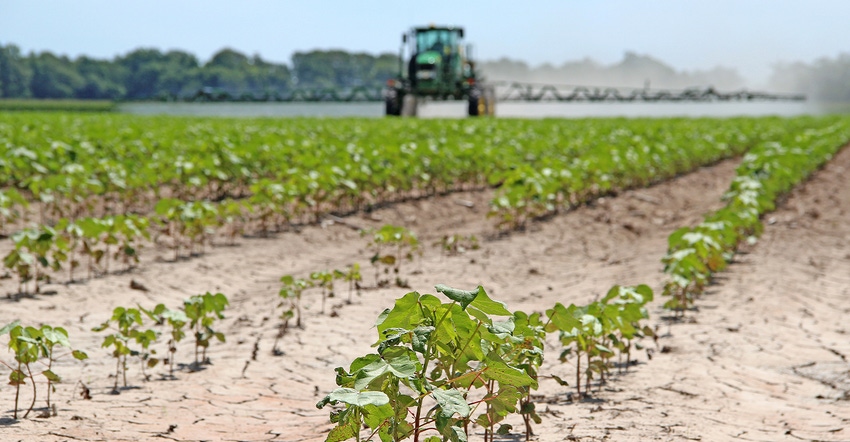
Insecticide resistance management is important to keep effective insecticides on the market and pests out of the field. Two experts discussed management practices to help prevent or delay resistance as well as the difference between insecticide resistance and insecticide tolerance.
Bruce Steward, Technical Service Manager for Oklahoma, Kansas, and the northern Texas panhandle with FMC, and Philip Northover, Technical Service Manager for southern California and Arizona with FMC, both spoke during an FMC webinar titled "Tools and Strategies for Insecticide Resistance Management."
The cost of insecticide resistance
The number one goal of insecticide resistance management is to prevent or delay resistance.
"Sometimes, we cannot prevent it completely, but with management practices, we can delay resistance to keep those insecticides available and keep the pest population susceptible to the sprays," Steward said. "It is important to help maintain the efficacy of these valuable insecticides."
Insecticide resistance costs the industry countless dollars.
"It is estimated that over $300 million is needed to make an insecticide as well as about eight to 10 years," Steward said. "If we utilize products correctly, we can save money. We can reduce the number of applications that are needed, and we do not have to use more expensive products or methods to control the pest. Also, we improve yields.
"If we are getting effective control, we can save time by spending less time making applications. Lastly, it protects your land. We are adding fewer active ingredients to the ecosystem, and there is less exposure to workers on the farm."
Insecticide application best practices include:
Follow the label rate.
Spray nozzles and equipment should be checked and calibrated.
Adjust the tank pH if needed after all products have been added to the tank.
Adjuvants can improve efficacy, coverage, and translaminar movement. Penetrant/spreading adjuvants may work best.
Do not leave insecticides in the tank overnight or for several days.
Do not leave a spray solution exposed to sunlight.
Use the proper rate and the correct timing of the life cycle.
Insecticide resistance or insecticide tolerance?
While insecticide resistance and insecticide tolerance may sound similar, they are two different concepts entirely, according to Northover.
"Insecticide resistance is not equal to insecticide tolerance," Northover said. "Tolerance is the natural ability of a population to withstand an effective insecticide, while resistance is increased survival over generations and is genetically inherited."
Tolerance is what happens when an insect can effectively deal with an insecticide. From the start, the insecticide does not work on them.
"Insecticide tolerance is a natural tendency of the organism to withstand the impact of a pesticide and is not the result of selection pressure like resistance is, so there is natural resistance," he said. "True insecticide resistance is developed from increased pressure due to insecticides.
"From a functional point of view, say you have a product that you have used for years and has worked well for you. You have not changed your practice much at all, but you are no longer seeing that level of control or management you were before. That could be suggestive of insecticide resistance, however, not necessarily."
Failures in insect control are not necessarily proof of resistance. Factors to poor pesticide performance can be attributed to, for instance, poor coverage or the pesticide being washed off from rainfall soon after applied.
"One of the first lines of defense for insecticide resistance management is the product label itself," Northover said. "Insects are classified by their mode of action, so all insecticides do not work the same way. When you are rotating chemistries and using different products, you do not want to necessarily rotate the name of the product. You want to make sure you are using different group numbers, which are listed on the products. The insecticide's group number is to help manage concerns related to insecticide resistance."
Steward and Northover suggest managing resistance through an integrated approach. Here are a few final tips for insecticide resistance management.
Tips to prevent the increase in resistant pest types:
Rotate crops to reduce the use of the same pesticides season after season.
Reduce nutrient sources such as plant stubble that can harbor pathogens and insects.
Weed management
If available, use scientifically verified methods to sample pest populations and correlate them to economic estimates of crop damage before applying pesticides.
Time chemical applications, rotating modes of action when the pest is most susceptible.
Scout before and after pesticide application to correctly identify the pest and to determine if the application provided effective control.
Rotate to a pesticide with a different mode of action.
Adhere to label rates for the specific pest, crop, conditions, and location.
Clean tillage and harvest equipment before moving from fields infested with resistant species.
About the Author(s)
You May Also Like




